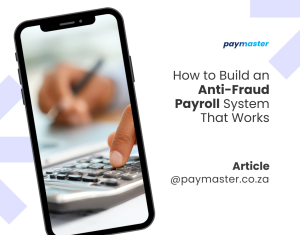Payroll is changing fast in 2025. New tools like automation, artificial intelligence (AI), and digital compliance systems are making it easier than ever to manage payroll. If your business keeps up with these changes, you can save time, avoid mistakes, and get more value from your payroll process.
Below, you’ll find four big trends in payroll—and simple steps you can take to get started.
1. Automation Makes Payroll Faster and Easier
First of all, automation is removing boring, repetitive tasks. Things like processing timesheets, creating payslips, and sending in reports can now happen automatically.
Why this matters:
This saves time, cuts down on errors, and helps everything run smoothly.
What you can do:
- Start using payroll software that automatically works out tax, benefits, and deductions.
- Set alerts to remind you about deadlines, like UIF, EMP201, and EMP501.
- Connect your leave and attendance systems to your payroll system so everything works together.
In short:
Automation helps you do more in less time—and with fewer mistakes.

2. AI Helps You Spot Problems Before They Happen
Next up, let’s take a closer look at AI. Right now, artificial intelligence is becoming a powerful tool in payroll. It studies patterns in your data and can often spot when something looks off—even before it becomes a serious problem.
Why this matters:
Because of this, AI can help you avoid expensive mistakes, like paying someone twice or forgetting to update important changes.
What you can do:
- First, use AI tools to quickly find issues like duplicate payments, missing data, or incorrect entries.
- Then, let machine learning analyse your payroll trends. That way, you can plan for salary increases, bonuses, or staffing needs more accurately.
- Also, try using chatbots to answer common employee questions—such as payslip details, leave balances, or tax deductions—without delay.
To sum up:
All in all, AI helps keep your payroll smart, accurate, and one step ahead. As a result, you save time, reduce stress, and boost your team’s confidence in the process.
3. Digital Compliance Tools Help You Stay on the Right Side of the Law
As rules and tax laws change, it’s important to keep up. Luckily, new payroll systems do that for you—automatically.
Why this matters:
Falling behind on legal changes can lead to big fines and stress.
What you can do:
- Use cloud-based payroll tools that update automatically with changes from SARS and other authorities.
- Make sure your software can create ready-to-send reports for IRP5, COIDA, and SDL.
- Keep all your records digital so you’re ready for audits and B-BBEE checks.
In other words:
Compliance doesn’t have to be stressful if your tools do the hard work for you.

4. Connecting Payroll with HR and Finance Helps Your Whole Business
Finally, payroll isn’t just about paying people anymore. These days, it plays a much bigger role in smart business planning. When you connect payroll with your HR and finance systems, not only do you speed things up, but you also get better data, clearer reports, and stronger decision-making support.
Why this matters:
As a result, your business can control costs more effectively, plan ahead with confidence, and better understand your team’s needs and performance.
What you can do:
- First, link your payroll system with your accounting and HR platforms. This way, you save time and avoid doing the same work twice.
- Next, share payroll information with your finance team. By doing so, you help them build accurate budgets and keep track of spending.
- Then, use dashboards and visual reports to see things like overtime, staff numbers, and labour costs. This gives you a quick overview of your workforce trends.
In short:
When everything is connected, payroll becomes more than just a task—it becomes a tool that helps your business run better, plan smarter, and grow stronger.
Conclusion:
To wrap it all up, payroll in 2025 is smarter, faster, and much easier—if you have the right tools. By using automation, AI, compliance support, and system connections, you can stay ahead, save time, and run your business better.
So, what’s next?
Start small. Pick one thing to improve—like setting up alerts or trying an AI tool. Then, keep going. Each step will make payroll less of a chore and more of a smart business tool.




